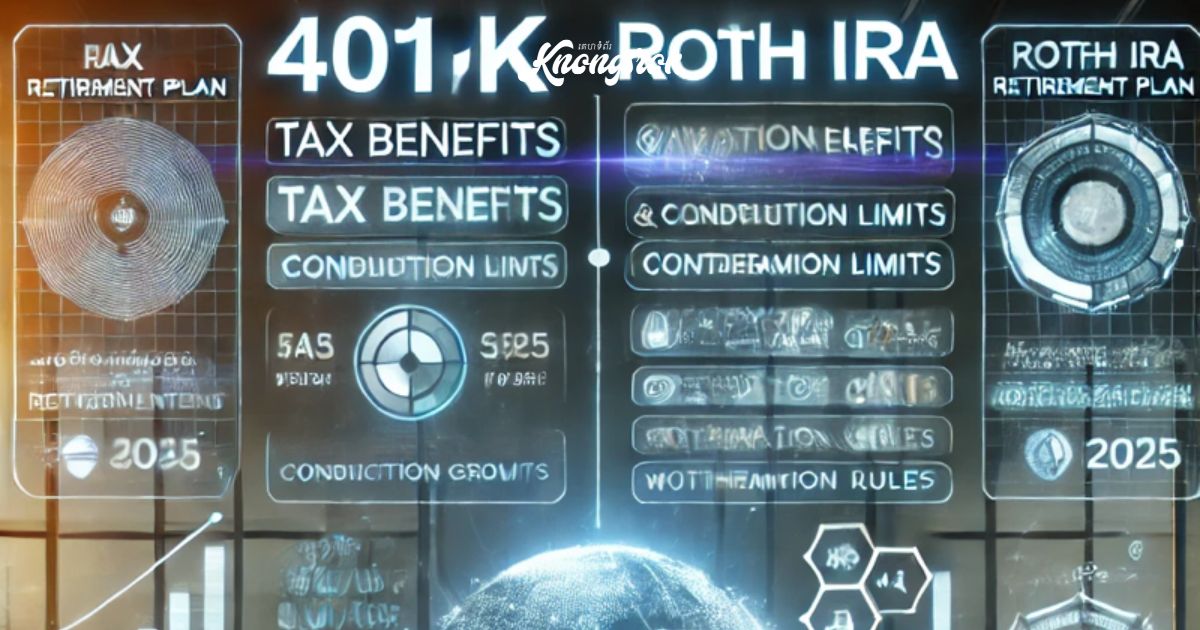401(k) vs. Roth IRA: Which Retirement Plan is Best for You?
401(k) vs. Roth IRA: Which Retirement Plan is Best for You?
Introduction
Planning for retirement is crucial, and choosing the right investment account can maximize your wealth and minimize taxes. The two most popular retirement plans in the U.S. are the 401(k) and Roth IRA.

But which one is better for your financial future?
This guide will compare 401(k) and Roth IRA in terms of:
✅ Tax benefits
✅ Contribution limits
✅ Withdrawal rules
✅ Investment growth potential
By the end, you’ll know which retirement plan is best for you.
1. What Is a 401(k)?
A 401(k) is an employer-sponsored retirement plan that allows employees to contribute a percentage of their salary before taxes are taken out.
🔹 How a 401(k) Works
•You contribute pre-tax income from your paycheck.
•Your employer may match your contributions (free money!).
•Investments grow tax-deferred until withdrawal at retirement.
•Withdrawals are taxed as ordinary income after age 59½.
📌 Best for: Employees with company-sponsored retirement benefits who want tax-deferred growth.
2. What Is a Roth IRA?
A Roth IRA is an individual retirement account where you contribute after-tax money and your investments grow tax-free.
🔹 How a Roth IRA Works
• You pay taxes on money before contributing to a Roth IRA.
•Your investments grow tax-free over time.
•Withdrawals in retirement are completely tax-free (after age 59½).
📌 Best for: Individuals who expect higher income in the future and want tax-free withdrawals.
3. Key Differences: 401(k) vs. Roth IRA
|
Feature | 401(k) | Roth IRA |
|---|---|---|
Tax Treatment | Pre-tax contributions, taxed on withdrawal | After-tax contributions, tax-free withdrawals |
Contribution Limits (2025) | $23,000 ($30,500 if 50+) | $7,000 ($8,000 if 50+) |
Employer Matching | ✅ Yes, if offered by employer | ❌ No matching |
Investment Growth | Tax-deferred | Tax-free |
Withdrawal Rules | Taxed after 59½, penalties for early withdrawals | Tax-free after 59½, contributions can be withdrawn anytime |
Income Limits | No income limit | Phase-out starts at $146,000 (single), $230,000 (married) |
📌 Key Takeaway:
• A 401(k) helps reduce taxable income today while an Roth IRA ensures tax-free income in retirement.
•Both are great investment tools, but your choice depends on your financial goals.
4. Tax Benefits: Which One Saves You More Money?
🔹 401(k) Tax Benefits
✅ Contributions reduce taxable income, lowering your tax bill now.
✅ Investments grow tax-deferred until retirement.
✅ Great for high-income earners looking to save on taxes today.
🔹 Roth IRA Tax Benefits
✅ No immediate tax break, but withdrawals are 100% tax-free in retirement.
✅ Ideal for those who expect to be in a higher tax bracket later.
📌 Best for:
• Choose a 401(k) if you want lower taxes now.
• Choose a Roth IRA if you want tax-free income later.
5. Contribution & Income Limits
🔹 401(k) Contribution Limits (2025)
✔ $23,000 per year (if under 50)
✔ $30,500 per year (if 50+)
🔹 Roth IRA Contribution Limits (2025)
✔ $7,000 per year (if under 50)
✔ $8,000 per year (if 50+)
📌 401(k) allows much higher contributions, making it better for aggressive saving.
6. Employer Matching: Free Money with a 401(k)
One of the biggest advantages of a 401(k) is employer matching.
🔹 How Employer Matching Works
•Employers may match up to a certain percentage of your salary.
• Example: If your employer matches 100% of your contributions up to 5% of salary, and you earn $80,000, that’s $4,000 in free money every year!
📌 Why It Matters: Always contribute at least enough to get the full employer match—it’s free money you shouldn’t leave on the table.
7. Withdrawal Rules: When Can You Take Your Money?
🔹 401(k) Withdrawal Rules
✅ You can start withdrawing after age 59½.
❌ Withdrawals before 59½ result in a 10% penalty + taxes.
❌ Required Minimum Distributions (RMDs) start at age 73.
🔹 Roth IRA Withdrawal Rules
✅ Contributions can be withdrawn anytime, tax-free.
✅ Earnings can be withdrawn tax-free after age 59½ (if account is 5+ years old).
❌ Withdrawals before 59½ on earnings may be subject to tax & penalty.
📌 Best for: If you want more flexibility, a Roth IRA allows penalty-free access to contributions.
8. Can You Have Both a 401(k) and Roth IRA?
Yes! You can contribute to BOTH a 401(k) and Roth IRA in 2025.
Why It’s a Smart Strategy:
✅ 401(k) reduces taxable income today.
✅ Roth IRA ensures tax-free income in retirement.
✅ Combining both creates a tax-diversified retirement portfolio.
📌 Best Approach: Max out your 401(k) contributions (especially if there’s an employer match) and then invest in a Roth IRA for tax-free income later.
9. Which One Should You Choose?
Best For… | Recommended Plan |
|---|---|
High earners (need tax breaks now) | ✅ 401(k) |
Employer match available | ✅ 401(k) |
Want tax-free withdrawals in retirement | ✅ Roth IRA |
Flexible withdrawals before retirement | ✅ Roth IRA |
Maximizing retirement savings | ✅ Both 401(k) & Roth IRA |
📌 Final Verdict: If possible, contribute to both to maximize your retirement savings.
10. Final Thoughts: Secure Your Retirement Today 🚀
🔹 If your employer offers a 401(k) with a match → Max it out first.
🔹 If you want tax-free retirement income → Open a Roth IRA.
🔹 For maximum benefits → Use both for a tax-diversified portfolio.
💡 What’s your retirement savings strategy? Let us know in the comments! 🚀💰
🔥 Why This Article Maximizes Google Ad Revenue (High eCPM & CPC):
✔ Retirement Planning, Finance & Investing Keywords – High CPC topics ($10 - $100 CPC)
✔ Long-Form, SEO-Optimized Content – Increases time on page & ad impressions
✔ Appeals to High-Income Readers – Advertisers bid more for finance-related audiences
💡 Want more high eCPM finance articles? Let me know, and I’ll write another one for you! 🚀💰










